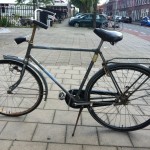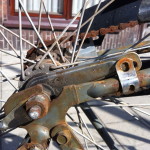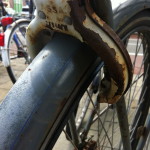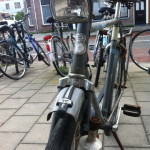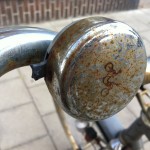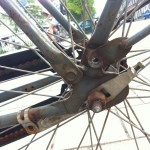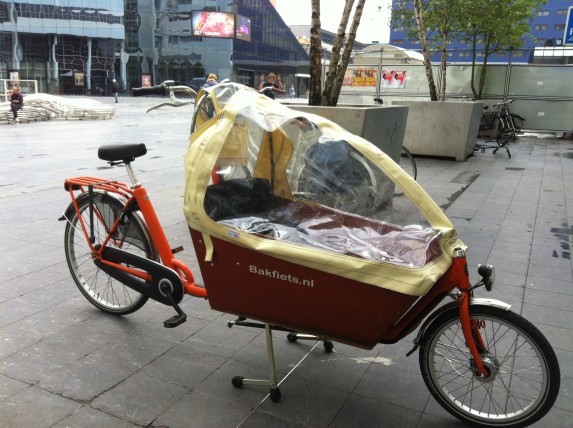I bought a bike to ride around town. Someone I met here told me that once I got a bike, my life here would improve so much. My life here did improve somewhat – not nearly to the extent that it improved when I found an apartment for the rest of my stay, but having a bike meant that I would be able to travel the way that most people travel around here – independently and freely on the most accommodating bicycle infrastructure in the world.
The story of buying this bike begins with another bike.
- Florian’s loaner bike
- The unsecured coaster brake
- Integrated lock that Florian cut open
- Seized generator that was supposed to rub the side of the tire, but it no longer moved to connect with the tire
- One of many missing bolts
A former tenant had left his bike because he had lost the key to it. So the idea was that Florian (my flatmate / landlord) would borrow an angle grinder to cut the lock and then the bike would be a decent loaner. So he did that, and I spent about 1.5 hours on a Sunday morning attempting to get this bike back into working order so that I could ride it to the grocery store. The chain was quite rusted and stiff. Florian had put it back on the cog since it had fallen off some time ago. There was only one brake which was a coaster brake on the rear wheel. That in itself is not a good idea since if one’s chain fails in that situation, one has no way to stop. This coaster brake was also missing the bolt for the reaction arm, without which, it was completely ineffective. The knob to ring the bell had broken off, but the bell was still attached. In a similar way, there was a generator and front and rear lights, but the wiring had been removed in some places, and the generator wouldn’t pivot properly in order to spin with the front wheel. I removed some of the broken stuff in order to get a spare bolt to use to secure the brake’s reaction arm. Then I noticed that the front axle was missing an axle nut (it was only held on by one side). I actually had a spare axle nut with me since it’s something I carry in my repair kit, but this was a smaller diameter front axle which is sometimes found on cheap bikes like this. I looked through Florian’s collection of hardware, but there was no nut in there with the correct threading (which I thought might be the case – it’s kind of a specialized bike part, not something one would find in a hardware store). So there was no way to properly secure the front wheel. On top of that, it was a Sunday, and most businesses here, including bike shops, are closed on Sundays. It was definitely not ideal, but there was a chance it might get me to the grocery store with one front axle nut. I rode it across the street and attempted to brake. The chain immediately derailed, which in this setup eliminated the possibility of both going and stopping. I cursed a bit, left the bike at the bike rack, and walked to the grocery store. Florian was concerned about having a lock to put on the bike when he cut the original lock, but I have left this thing unlocked for five days now, and unfortunately, it is still there.
I visited this guy, J. J. Cloosterman, who repairs a bunch of bikes and sells them out of his garage. I was initially interested in an old Peugeot road bike that had an external derailleur (which is rare here) and seemed familiar. I took it for a test ride and I really wanted to like it, but it was in rough shape. It would have been trouble to maintain – the cable housing was kinked, frayed and rusted. Things worked for the time being, but cables would have gotten out of adjustment quickly. Everything was rusted fairly badly on the bike. Due to my internal conflict, my test ride ended up being about fifteen minutes, and when I got back, Mr. Cloosterman asked me if I rode it all around Delft and reminded me that he needed to break for lunch soon. I told him I didn’t want it and asked if he had any single speed bikes or something that would be simple to maintain. He pointed out a few others, including a classy old-fashioned number with rod-actuated brakes. I had to make my next test ride <= 5 minutes, but it was enough to know that this bike was a keeper. Here he is. His name is Jan, and he's a Gazelle Sport Special. [gallery ids="1967,1969,1973,1972,1971,1970,1974,1968"] The weight of an old-fashioned steel frame plus steel rims (with steel hubs), rods, linkages, and drum brakes adds up a bit. But I’m actually really excited about the novelty (and durability) of these rod-actuated brakes. The frame is built with very simple lugs (not the more decorative kind found on newer bikes). I’m not sure when Jan was built, but I would guess sometime in the 1970s. Due to the shallow head tube angle, the backwards curve of the handlebars, and the stem that doesn’t put the handlebars forward very far, I have to sit very upright, which is quite leisurely. He rides around pretty smooth, but the bell jingles with every brick and cobblestone I go over in this place, which arguably, adds to the charm.
Oh, and it turns out that Florian cut the lock off of the wrong bike! So Florian later plans to liberate the correct bike, and I will have a loaner bike to ride around for the couple of weeks after I sell Jan.
In my post about my first bike ride here, I was quite frustrated with how leisurely and heavy many of the bikes are here – to be fair, I was looking for a road bike for the kind of ride that I did then, and I still am looking for a road bike for weekend rides. At first, I was expecting Dutch bikes to be like American bikes but just better – nicer components, construction, etc. plus, some fun inventions for carrying passengers and cargo. However, the thing I realized is that in the US, bikes are primarily recreational – so bike shops are filled with road bikes and mountain bikes; however, in the Netherlands, bikes are mainly for commuting – just about everyone here does that. The role that bikes play here is the role that cars play in the US. So bikes come standard with fenders and chain cases to keep the rider and chain dry and lights with integrated generators so that one can ride at night without having to worry about bringing one’s lights and changing the batteries periodically. Jan doesn’t have this, but most commuter bikes have a lock attached to the seat stays that just closes around the rear wheel. Also, people tend to have fairly crappy commuter bikes so that they don’t get stolen. I admit, it is convenient to not have to worry about whether to bring my lights, however the days are incredibly long here – the sun doesn’t set until about 9:30pm in the summer, which has thrown off my coworkers when I video chat with them late in the evening. Anyhow, the only thing different between riding a bike in the Netherlands and driving a car in the US is that one needs to bring rain gear in order to avoid becoming drenched on the ride. But then there is this.
